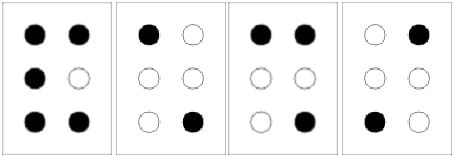UNDERSTANDING THE BRAILLE LANGUAGE & PROVIDING PROFESSIONAL BRAILLE INTERPRETERS, TRANSLATORS AND TRANSCRIPTIONISTS
American Language Services (AML-Global) understands the importance of working in the Braille language. For over a Quarter of a Century, American Language Services has worked with the Braille language as well as hundreds of others from around the world. We offer comprehensive language services 24 hours, 7 days a week worldwide by providing Braille interpreting, translation and transcriptions services along with hundreds of other languages and dialects. Our linguists are native speakers and writers who are screened, credentialed, certified, field tested and experienced in a number of specific industry settings. The Braille language is unique and has very specific origins and characteristics.
Louis Braille and His Simplification of the Braille System
Developed in response to Napoleon’s demand for a code that soldiers could use to communicate silently, Braille is now used by the blind as a method to read and write. It was devised in 1821 by Louis Braille . Louis was blinded after an infection took hold of his eye and left him completely blind, determined he was sent to the Royal Institution for Blind Youth in Paris where he used his creativity to invent an easy and quick way for the blind people to read and write. Charles Barbier de la Serre was the first to attempt such a system but the soldiers who tried to learn his method found it too difficult. Louis worked with Barbier’s basic ideas and simplified it by using a method of six dots arranged in a cell. This allowed the human finger to “read” a cell without having to move the finger around. Unfortunately, during his time Louis Braille’s system was not instituted into wide use until his death of tuberculosis. Today, in virtually every language around the world, Braille is the standard form used to read and write by the blind.
The Use of Cells, Six Dots and Contractions in the Braille Alphabet
The Braille alphabet can be seen as the world’s first binary encoding system for representing the characters of a writing alphabet. Different Braille codes are used for different things like mathematics and music, however, many Braille characters have different meanings based on their context. Braille operates on the basic principal of a cell, with six raised dots arranged in a grid of two dots horizontally by three dots vertically. The absence or patterns of the dots arranged within the cell correlate to a letter. There is no phonology to the Braille system since it is a method based upon touch. Interestingly, Braille contractions are represented in this matrix of cells, an example of this is shown below.

The word AND The letters CH The letters SH The Letters ST
Braille Transcription
Braille transcription is a unique process done simply by substituting the equivalent Braille Character for its printed equivalent. There is a catch however, because Braille characters are much larger than their printed equivalents, space must be used in a conservative matter in order to increase reading speed. To further enhance read speed portions of words must be contracted using a Grade 2 Braille system.
Who are You Going to Trust with Your Vital Braille Language Needs?
The Braille language is an important language worldwide. It is vital to understand the general nature and specific idiosyncrasies of Braille. Since 1985, AML-Global has provided outstanding Braille interpreters, translators and transcriptionsts worldwide.























